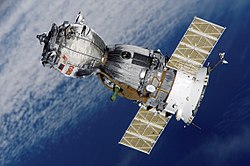 Soyuz MS-26 approaches the International Space Station | |
| Names | ISS 72S |
|---|---|
| Mission type | ISS crew transport |
| Operator | Roscosmos |
| COSPAR ID | 2024-162A |
| SATCAT no. | 61043 |
| Mission duration | 220 days, 8 hours and 57 minutes |
| Distance travelled | 150,200,000 km (93,300,000 mi) [1] |
| Orbits completed | 3,520 [1] |
| Spacecraft properties | |
| Spacecraft | Soyuz MS-26 No. 757 |
| Spacecraft type | Soyuz MS |
| Manufacturer | Energia |
| Launch mass | 7,152 kg (15,767 lb) [2] |
| Crew | |
| Crew size | 3 |
| Members | |
| Callsign | Burlak |
| Expedition | Expedition 71/72 |
| Start of mission | |
| Launch date | 11 September 2024, 16:23:12 UTC (21:23:12 AQTT) |
| Rocket | Soyuz-2.1a No. M15000-070 [2] |
| Launch site | Baikonur, Site 31/6 |
| Contractor | RKTs Progress |
| End of mission | |
| Landing date | 20 April 2025 01:20:35 UTC |
| Landing site | Kazakh Steppe, 147 km (91 mi) southeast of Zhezkazgan, Kazakhstan ( 47°19′N69°33′E / 47.317°N 69.550°E ) [2] |
| Orbital parameters | |
| Reference system | Geocentric orbit |
| Regime | Low Earth orbit |
| Inclination | 51.66° |
| Docking with ISS | |
| Docking port | Rassvet nadir |
| Docking date | 11 September 2024, 19:32:09 UTC |
| Undocking date | 19 April 2025, 21:57:33 UTC |
| Time docked | 220 days, 2 hours and 25 minutes |
 Mission patch, which depicts the three crew members as Burlak (the mission's callsign) pulling the Soyuz [3]  From left: Vagner, Ovchinin and Pettit | |
Soyuz MS-26, Russian production No. 757 and identified by NASA as Soyuz 72S, was a Russian crewed Soyuz spaceflight launched from Site 31/6 at the Baikonur Cosmodrome on 11 September 2024 to the International Space Station. [4] [5] [6] The mission transported three crew members, Roscosmos cosmonauts Aleksey Ovchinin and Ivan Vagner, along with NASA astronaut Donald Pettit.
Contents
When the spacecraft crossed the Karman line shortly after launch, there was a record 19 people in outer space: the three astronauts on the MS-26 mission, three more on China's Tiangong space station, four people on the SpaceX Polaris Dawn mission, and nine more on board the International Space Station. [7]







